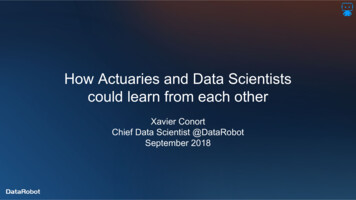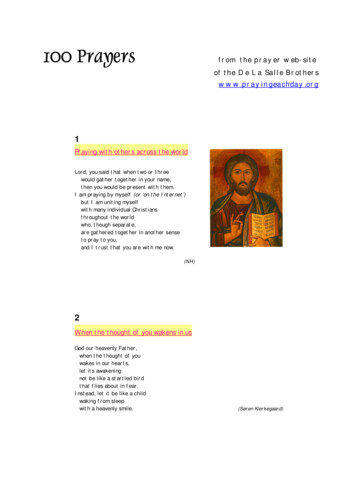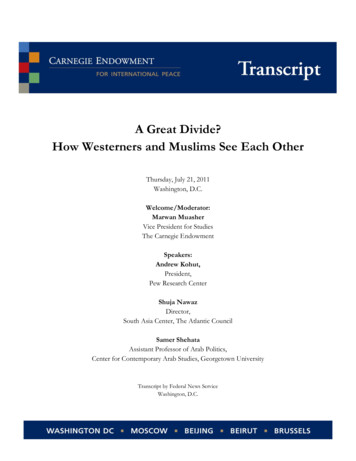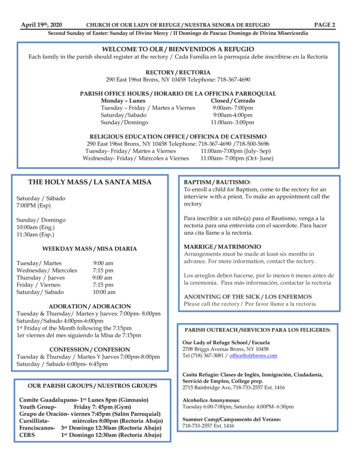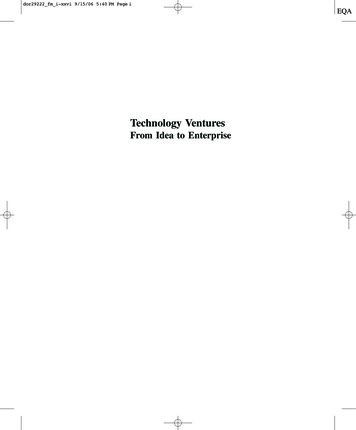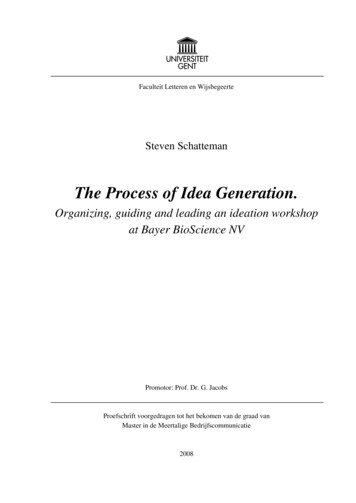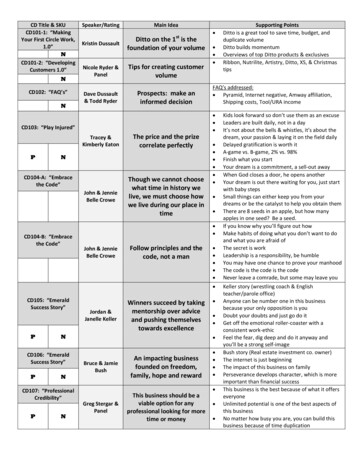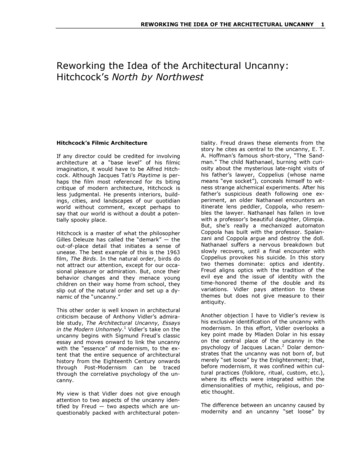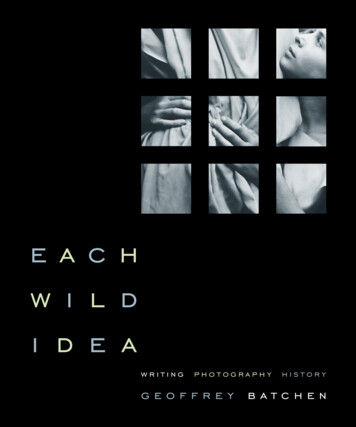
Transcription
eachw i l di d e awritingphotographyhistorygeoffrey batchen
each wild idea
the mit press c a m b r i d g e , m a ss a c h u s e tt slondon, england
eachw i l di d e awritingphotographygeoffreyhistorybatchen
2000MASSACHUSETTS INSTITUTE OF TECHNOLOGYALL RIGHTS RESERVED . NO PART OF THIS BOOK MAY BE REPRODUCED IN ANYFORM BY ANY ELECTRONIC OR MECHANICAL MEANS ( INCLUDING PHOTOCOPYING , RECORDING , OR INFORMATION STORAGEAND RETRIEVAL ) WITHOUT PERMISSION IN WRITING FROM THE PUBLISHER .THIS BOOK WAS SET IN ADOBE GARAMOND , ENGRAVERS GOTHIC , AND OFFICINA SANS BY GRAPHIC COMPOSITION , INC .PRINTED AND BOUND IN THE UNITED STATES OF AMERICA.LIBRARY OF CONGRESS CATALOGING - IN - PUBLICATION DATA(TOCOME )
Not however expecting connection, you must just accept of each wild idea as it presents itself.—Thomas Watling, Letters from an Exile at Botany-Bay, 1794
contents
preludeviii123desiringproductionaustralian madevernacularphotographies26256456taking and makingpost - photographyectoplasm82108128789photogenicsobedient numbers,soft delightda [r] ta146176164notes192index230
preludeThere can be something quite disconcerting about anthologies like this one. Nine essays bya single author are garnered from a variety of sources and presented as a coherent narrative.Congealed each in the moment of its initial publication, such essays usually provide littlemore than an archaeology of these past moments, a history of the unfolding of history itself.Each Wild Idea certainly repeats this model; its chapters incorporate essays already publishedelsewhere (in academic journals, exhibition catalogues, and art magazines). But this book isnot only a record of past publications, for these publications all appear here in revised and/orexpanded form, having been brought up to date and often stitched together into broader arguments bearing on photography and the writing of its history. In other words, like the photography they discuss, these essays take up the kernel of an initial exposure and subject it tocontinual development, reproduction, and manipulation. Written through a process of accretion, they are presented here as works in progress, coming from the past but still in motion, (never) to be completed, and therefore also of and about the present.The subjects of these essays range widely, from a discussion of the timing of photography’s invention to analyses of the consequences of cyberculture. In between there are reflections on the Australianness of Australian photography (another indication of my ownhistorical trajectory), the state of contemporary art photography, and the place of the vernacular in photography’s history. In each case, readers are faced with having to determine therelationship of form and history, and therefore of being and identity, a crucial yet complicated spacing too quickly stilled by the formalist and postmodern approaches that continueto dominate photographic discourse. Thus, despite its variety of themes, Each Wild Idea ismarked by a constant refrain throughout: the vexed (and vexing) question of photography’spreludepast, present, and future identity.A brief note on method would seem to be appropriate. Informed by the aspirationsand rhetorics of postmodernism, this book engages the semiotics of photographic meaning.
It assumes, in other words, that the meaning of every photograph is imbricated withinbroader social and political forces. However, my writing does not want to regard this production as simply a cultural matter, as if meaning and politics infiltrate the passively waitingphotograph only from the outside. What is the photograph on the inside, before it enters aspecific historical and political context? The question is an impossible but necessary one—impossible because there can never be an unadulterated “before,” necessary because thepositing of an originary moment is the very condition of identity itself.This Prelude, for example, comes before the chapters that make up the rest of this bookand yet was written after them. To read it now is to experience a peculiar convolution of spatial and temporal orders, a kind of convolution that constantly reappears throughout theseessays. For my interest here is in the way photography is inevitably an “impossible” implosion of before and after, inside and outside. I want to articulate photography as somethingthat is simultaneously material and cultural, manifested as much in the attributes of the photographic object as in its contextualization. Philosophy has a word for all this: deconstruction.In the words of Gayatri Spivak, “The sign must be studied ‘under erasure’, always already inhabited by the trace of another sign which never appears as such. ‘Semiology’ must give wayto ‘grammatology’.” The language is difficult to grasp, but so is the agency it seeks to describe.And even when this agency is conceded, one might well still want to ask, So how does thistracing embody itself in and as the flesh of a photograph? This could be taken as the motivating challenge of Each Wild Idea.The essays that follow ponder this question in any number of ways, but they all taketheir cues from a consideration of the particularities of specific photographs. If nothing else,my discussions should remind us of photography’s wonderful strangeness (inference: you donot have to read theory to encounter the dynamics of a photogrammatology—just look atthe evidence of history itself ). Each Wild Idea is a compendium of such evidence, finding itin everything from a master work by Alfred Stieglitz to a humble combination of baby photoand bronzed booties. I show that both examples incorporate their own singular histories(they are not just in history; they are history). The difficulty is conveying this process througha piece of writing. To my surprise, I have often found myself gravitating toward sheer description as a mode of analysis, thus insisting that we look right at, rather than only beyond,the formal qualities of the photograph being discussed. This attention to form has little toix
do with a desire to reveal photography’s essential characteristics as a medium (the purportedambition of the kind of formalism to which postmodernism has traditionally opposed itself ).It is, rather, an effort to evoke directly the lived experience of history, a reminder that historyis continually unfolding itself in the materiality of the present—in the presentness of whatever photograph, from whatever era, happens to be before us. Once again Roland Barthes isproved right: “To parody a well-known saying, I shall say that a little formalism turns oneaway from History, but that a lot brings one back to it.”All intellectual work is a collective enterprise, and the endnotes to the essays that follow testify to the degree to which my own thinking has always been dependent on that of others.But this Prelude also allows me to thank the many people to whom I am more personally indebted. These acknowledgments in turn reveal the degree to which this anthology is autobiographical in character. The book’s shifts in focus and methodology, and the pattern ofindividuals who contributed to those shifts, speak to my own developing career as a writer ofhistorical criticism, as well as to my current identity as an expatriate Australian working inthe United States.Some of these essays were begun ten years ago in Sydney, Australia. The insights andsuggestions of Vicki Kirby considerably improved my early work and still guide my thinking today. The work of Australian artist and writer Ian Burn offered a model of engaged cultural criticism that I continue to try to emulate. More recently I have been particularlyfortunate in having graduate students at the University of New Mexico who have tolerated,challenged, and encouraged my work in all sorts of ways; these students have included Monica Garza, Shari Wasson, Nina Stephenson, Patrick Manning, Marcell Hackbardt, Are Flågan, Erin Garcia, Rachel Goodenow, and Sara Marion. I especially want to thank DanielleMiller for fostering a life in which critical writing could be produced. I also acknowledge colleagues at UNM—Christopher Mead, Thomas Barrow, Charlene Villaseñor Black, Elizabeth Hutchinson, and Carla Yanni—who have given me both moral and physical supportpreludewhenever I have needed it. Tom Barrow in particular has been a constant source of encouragement and assistance.Both Marlene Stutzman and Monica Garza worked as my research assistants duringthis book’s formation; their dedication and care have been essential to its completion. Marx
cell Hackbardt made a number of the reproduction photographs that appear here, for whichI am duly grateful. Are Flågan also helped by turning some of the illustrations into digitalfiles. The employment of all of these people was made possible by generous grants from theUniversity of New Mexico: a 1996–1997 Research/Creative Work Grant from the Dean’sOffice of the College of Fine Arts and a 1998 Research Allocations Committee Grant.Many other individuals, some of whom I have never met in the flesh, have been verygenerous in sharing their advice, ideas, and research; these include Sue Best, Carol Botts,Martin Campbell-Kelly, Helen Ennis, Anne Ferran, Are Flågan, Douglas Fogle, HollandGallop, Monica Garza, Alison Gingeras, Michael Gray, Sarah Greenough, Kathleen Howe,Elizabeth Hutchinson, Daile Kaplan, Tom Keenan, Richard King, Vicki Kirby, CarolineKoebel, Josef Lebovic, Patrick Manning, Danielle Rae Miller, Gael Newton, Douglas Nickel,Tim Nohe, Alex Novak, Eric Riddler, Larry Schaaf, Ingrid Schaffner, Susan Schuppli, JohnSpencer, Ann Stephen, Peter Walch, and Catherine Whalen.I thank the many institutions that granted permission to reproduce images in thisbook. A number of individuals also generously provided permissions and/or illustrative material; they include Hans Krauss, Jill White, and James Alinder. Some of the artists discussedhere have been unusually helpful in providing information about their work; in particular, Ithank Sheldon Brown, Jennifer Bolande, Anne Ferran, Jacky Redgate, Laura Kurgan, EllenGarvens, Rachel Stevens, Andreas Müller-Pohl, Lynn Cazabon, and Igor Vamos. Most ofthese essays appeared in fledgling form in journals and magazines (listed at the end of eachessay), and I thank the many editors and publishers concerned, both for their initial supportand for agreeing to their reproduction here. I also gratefully acknowledge the support andadvice of my editor at The MIT Press, Roger Conover, the editorial expertise of SandraMinkkinen, and the marvelous work of designer Ori Kometani.Finally, I simply thank all those friends who in various ways have sustained my lifewhile these essays were being written. Their interest and care are what make such writingpossible.xi
xiiprelude
eachw i l di d e a
1 desiring production
“Begin at the beginning,” the King said, very gravely, “and go on till you come to the end:then stop.”—Lewis Carroll, Alice in WonderlandThe King’s advice to Alice, has been taken to heart by those who write the history of photography.1 The end is apparently not yet in sight, but the beginning is in almost everyaccount identified with the invention of a marketable photographic apparatus and thesuccessful production of the first photographs. Not only does this originary event mark thestarting point, or at least the first climactic moment, of their narrative structures; it has cometo represent the one common empirical incident in an otherwise unruly and quarrelsome ensemble of photographic practices and discourses. For this reason, the story of the inventionof photography has become the stable platform on which all the medium’s many subsequentmanifestations are presumed to be founded. (To paraphrase Jacques Derrida, photography’shistorians have a vested interest in moving as quickly as possible from the troubling philosophical question, “What is photography?” to the safe and expository one, “Where and whendid photography begin?”)2 At the same time, the circumstances of photography’s inventionare commonly used to establish the medium’s continuity with a linear development of Western practices of representation reaching back to, inevitably, the Renaissance. Any questioning of photography’s beginnings therefore also represents a questioning of the trajectory ofphotography’s history as a whole.It was on January 7, 1839, in the form of a speech by François Arago to the FrenchAcademy of Sciences, that the invention of photography was officially announced to theworld.3 Further enthusiastic speeches about Louis Daguerre’s amazing image-making processwere subsequently made to the Chamber of Deputies on June 15 and finally to a combinedmeeting of the Academy of Sciences and Fine Arts on August 19. It was only on this latterdate that the daguerreotype and its camera apparatus were ready to be introduced to an already eager market. Indeed, so eager was this market that within the space of a few months,the daguerreotype had found its way to almost every corner of the globe and infiltrated almost every conceivable genre of image making. Meanwhile, over in England, William HenryFox Talbot had been motivated by the news of Daguerre’s discovery to announce hurriedly3
that he had also been conducting some experiments with a photographic process. His process, significantly different from that devised by Daguerre, was subsequently described in detail on January 31, 1839, in a paper delivered to the Royal Society. After undergoing a fewrefinements, Talbot’s paper-based image and negative-positive method proved even moreamenable than the daguerreotype to a wide variety of uses and provided the basic principlesof the photography we still use today.So no one would want to deny that 1839 was an important year in the life of photography, particularly with regard to the direction of its subsequent technical, instrumental, andentrepreneurial developments. However, the traditional emphasis on 1839, and the pioneering figures of Daguerre and Talbot, has tended to distract attention from the wider significance of the timing of photography’s emergence into our culture. This essay aims first toestablish this timing and then to articulate briefly something of that significance.In the introduction to his authoritative tome The Origins of Photography, HelmutGernsheim went so far as to describe the timing of photography’s invention as “the greatestmystery in its history”: “Considering that knowledge of the chemical as well as the opticalprinciples of photography was fairly widespread following Schulze’s experiment [in 1725]. . . the circumstance that photography was not invented earlier remains the greatest mysteryin its history. . . . It had apparently never occurred to any of the multitude of artists of theseventeenth and eighteenth centuries who were in the habit of using the camera obscura totry to fix its image permanently.”4Why 1839 and not before? Why, for example, didn’t any of the great thinkers of thepast—Aristotle, Leonardo, Newton—come up with this idea, even if only in the form of textual or pictorial speculation? This is the question that continues to haunt the history of photography’s invention. But how are the medium’s historians to engage with it? More to thepoint, how are we to develop a critical, and, from that, a political understanding of photogdesiring productionraphy’s timing? Perhaps the historical methods of French philosopher Michel Foucault maybe helpful. Foucault’s various archaeologies have, after all, concerned themselves at least inpart with a critique of traditional historical ideas about invention and beginnings.“Archaeology is not in search of inventions, and it remains unmoved at the moment(a very moving one, I admit) when, for the first time, someone was sure of some truth; it doesnot try to restore the light of those joyful mornings. But neither is it concerned with the4
average phenomena of opinion, with the dull gray of what everyone at a particular periodmight repeat. What it seeks is not to draw up a list of founding saints; it is to uncover the regularity of a discursive practice.”5Following Foucault, we might find it useful to shift the emphasis of our investigationof photography’s timing from 1839 to another, earlier moment in the medium’s history: tothe appearance of a regular discursive practice for which photography is the desired object.The timing of the invention of photography is thereby assumed to coincide with its conceptual and metaphoric rather than its technological or functional manifestations. Accordinglythis essay will ask not who invented photography but, rather, At what moment in history didthe discursive desire to photograph emerge and begin to manifest itself insistently? At whatmoment did photography shift from an occasional, isolated, individual fantasy to a demonstrably widespread, social imperative? When, in other words, did evidence of a desire to photograph begin to appear with sufficient regularity and internal consistency to be described inFoucault’s terms as a discursive practice?One historian, Pierre Harmant, has already offered a surprisingly crowded list oftwenty-four people who claimed at one time or another to have been the first to have practiced photography; seven of these came from France, six from England, five from Germany,one from Belgium, one was American, one Spanish, one Norwegian, one Swiss, and oneBrazilian. Upon further examination of their claims, Harmant concluded that “of these, fouronly had solutions which were truly original.”6 However, this is not a criterion that is particularly pertinent to an investigation of the desire to photograph. It is, after all, the timingand mythopoetic significance of such a discourse that is at issue rather than the historical accuracy or import of individual texts or claimants. Originality of method, accuracy of chemical formulas, success or failure: these irrelevancies need not be taken into account whencompiling a list of names and dates of those who felt a desire to photograph. All that need bedeleted from such a list are those persons, and there are many of them, who began their experiments only after first hearing of the successes of either Daguerre or Talbot.7 These missing figures were often important to the future developments of photography as a technologyand a practice. However, as far as the emergence of a photo-desire is concerned, they represent no more than, as Foucault unkindly puts it, “the dull gray of what everyone at a particular period might repeat.”5
Here then is my own roll call, undoubtedly an incomplete and still speculative one,of those who recorded or subsequently claimed for themselves the pre-1839 onset of a desire to photograph: Henry Brougham (England, 1794), Elizabeth Fulhame (England, 1794),Thomas Wedgwood (England, c.1800), Anthony Carlisle (England, c.1800), HumphryDavy (England, c.1801–1802), Thomas Young (England, 1803), Nicéphore and ClaudeNiépce (France, 1814), Samuel Morse (United States, 1821), Louis Daguerre (France,1824), Eugène Hubert (France, c.1828), James Wattles (United States, 1832), HerculesFlorence (France/Brazil, 1832), Richard Habersham (United States, 1832), Henry Talbot(England, 1833), Philipp Hoffmeister (Germany, 1834), Friedrich Gerber (Switzerland,1836), John Draper (United States, 1836), Vernon Heath (England, 1837), Hippolyte Bayard (France, 1837), José Ramos Zapetti (Spain, 1837).8These are the persons we might call the protophotographers. As authors and experimenters, they produced a voluminous collection of aspirations for which some sort of photography was in each case the desired result. Sometimes this is literally so. We find Niépce writingin 1827 to Daguerre—for example, “In order to respond to the desire which you have beengood enough to express” (his emphasis)—and find Daguerre replying in the following year that“I cannot hide the fact that I am burning with desire to see your experiments from nature.”9On other occasions we are left to read this desire in the objects these people sought to have represented—invariably views (of landscape), nature, and/or the image found in the mirror of thecamera obscura—or alternatively in the words and phrases they use to describe their imaginaryor still-fledgling processes. Davy’s 1802 paper about the experiments of himself and his friendTom Wedgwood, for example, records their attempts to use silver nitrates and chlorides to capture the image formed by the camera obscura, followed by similar efforts to make contact printsof figures painted on glass as well as of leaves, insect wings, and engravings. The Niépce brothers seem to have been inspired by lithography in their experiments to make light-induced copiesdesiring productionof existing images, although from 1827 on, Nicéphore concentrated his energies on the possibility of making “a view from nature, using the newly perfected camera.” This is an ambitionalso expressed by Indiana student James Wattles, who in 1828 made a temporary image in hiscamera of “the old stone fort in the rear of the school garden.” In about this same year, Frencharchitect Eugène Hubert attempted to produce camera images of plaster sculptures, and in1833 Brazilian artist Hercules Florence made experimental views from his window.106
So the celebrated photographic experiments of Henry Talbot, begun only in 1833,should be regarded as but one more independent continuation of a desire already experienced by many others. Once a technical solution to this desire had occurred to him, Talbotquickly produced contact prints of botanical specimens, pieces of lace, and his own handwriting, then images projected by his solar microscope, and finally pictures of his familyhome, Lacock Abbey, imprinted on sensitized paper placed in the back of a small cameraobscura. By the 1840s he had also made a wide variety of other types of image. Historianstend to regard most of these images simply as straightforward demonstrations of his process. However, some, like Mike Weaver, argue that at least one or two of them “produced ametaphorical rather than purely descriptive account of reality.”11 I would go even further andsuggest that Talbot was an omniverous but never arbitrary image maker; all of his pictureshave metaphorical meanings.A case in point is the series of tiny pictures Talbot made of the inside of the windowfrom the South Gallery of Lacock Abbey. This oriel window is the subject of an oftenreproduced image, Talbot’s earliest extant negative, taken in August 1835. As Talbot pointsout in a hand-written inscription next to this negative (perhaps added when it was exhibitedin 1839), the number of squares of glass can be counted with the help of a magnifying lens.And if we take his advice and look more closely, we also see that it is a landscape image, forwe can just glimpse the silhouetted forms of trees and bushes through the window’s transparent panes. Interestingly, Talbot repeats this same basic composition in at least five othernegatives, some also made in 1835 and others made perhaps four years later.12 In all six cases,Talbot’s picture shows us nothing but this window; it fills the picture plane entirely, resulting in an abstract blue and white pattern of diamond shapes framed only by the more solidoutlines of the latticed window structure itself. (photo 1.1) So why would Talbot make atleast six pictures of nothing—of nothing but panes of glass, of a subject with no particularintrinsic interest, either as science or art?Talbot expert Larry Schaaf implies that a fireplace mantle opposite this window madeit an attractive platform for Talbot’s primitive camera, allowing him to make a high-contrastnegative in favorable environmental conditions.13 Talbot had rebuilt this particular room asa potential art gallery after he occupied the family home in 1827, completing the job in1831. The space featured three bay windows, with Talbot choosing to photograph only the7
desiring production1.1William Henry Fox Talbot, The Oriel Window, Lacock Abbey, seen from the inside, c. Summer 1835Photogenic drawing negativeMetropolitan Museum of Art, New York8
central and smallest example, at a point where the room has narrowed into little more thana wide corridor. He points his camera directly into the light, directly at that feature of theroom that is neither inside nor outside but both. What is particularly interesting about thesewindow pictures is that Talbot makes no effort to describe the space of the gallery itself, ashe does in a number of later pictures of interiors (Interior of South Gallery, Lacock Abbey,November 23, 1839, or March 2, 1840) and their windows. Nor does he allow the window’slight to be cast over something else (implying spiritual or intellectual enlightenment), as hedoes over a bust of Patroclus in a print from November 1839 or over the objects in Windowseat, from May 30, 1840. He instead produces an entirely flat, virtually abstract image, animage that emulates the equally flat and already familiar two-dimensional look of the contact print. It is as if he wants to tell us that this window has imprinted itself directly onto hispaper, without the mediation of composition or artistic precedent.This is soon to become a common pictorial option for Talbot; glassware, ceramic vessels, figurines, shelves of books, and even an array of hats all eventually get the same treatment. In each case, Talbot carefully arranged these tiers of objects out in the courtyard ofLacock Abbey in order to exploit the best possible lighting conditions. In other words, hefakes their setting; he asks these objects to perform as if they are somewhere they are not, asif they were sitting indoors. The images that result employ the aesthetic of modern scientificanalysis and commercial display. However, it is also a way for Talbot to emphasize the emblematic over the naturalistic possibilities of photographic representation. But emblematicof what?Could the window picture be read as an emblem of itself, of the very photogenic drawing process that has made its own existence possible? When you think about it, Talbot hasset up his camera at exactly the point in the South Gallery where the sensitive paper once satin his own modified camera obscura. His camera obscura looks out at the inside of the metaphorical lens of the camera of his own house (which he later claimed was “the first that wasever yet known to have drawn its own picture”).14 He is, in other words, taking a photographof photography at work making this photograph. In a letter to Lady Mary Cole about herown photographic “experimentalizing,” dated August 9, 1839, Talbot advised her that “the object to begin with is a window & its bars placing the instrument in the interior of the room.”15So, for Talbot, a picture of the inside of a window is an exemplary photograph—the first9
photograph one should attempt, the origin point of one’s photography, the origin of all photography. Where Niépce and Daguerre both take pictures from their windows, Talbot makesan image of his window. He tells us that photography is about framing, and then shows usnothing but that frame; he suggests that photography offers a window onto the world, butthen shows nothing but that window.16 As Derrida suggests, “The time for reflection is alsothe chance for turning back on the very conditions of reflection, in all senses of that word, asif with the help of a new optical device one could finally see sight, one could not only viewthe natural landscape, the city, the bridge and the abyss, but could view viewing.”17 This,then, is no ordinary picture. It is rather what Talbot elsewhere called a “PhilosophicalWindow.”18But there is still more to this picture. His camera also looks from the perspective of Talbot himself, as if the photographer was leaning up against the wall opposite (literally sittingor standing in the place of the developing photograph). In other words, Talbot’s camera obscura acts in place of his own sensitized eye, as a detachable prosthesis of his own body (hehimself referred to the “eye of the camera” in his 1844 book, The Pencil of Nature).19 It is aphotograph of the absent presence of the photographer. In 1860, George Henry Lewes, inhis The Physiology of Common Life, suggested that if “we fix our eyes on the panes of a window through which the sunlight is streaming, the image of the panes will continue some seconds after the closure of the eyes.”20 Talbot’s serial rendition of his own window demonstratesprecisely this afterimage effect, projecting the photographs that result as retinal impressions,retained even after the eye of his camera has been closed.In effect, this deceptively simple image articulates photography not as some sort ofsimply transparent window onto the real, but as a complex form of palimpsest. Nature, camera, image, and photographer are all present even when absent from the picture, as if photography represents a perverse dynamic in which each of these components is continuallydesiring productionbeing inscribed in the place already occupied by its neighbor. In Talbot’s hands, photography is neither natural nor cultural, but rather an economy that incorporates, produces, andis simultaneously produced by both nature and culture, both reality and representation (andfor that very reason is never simply one or the other).Talbot offers another, equally complex, articulation of photography in his first published paper on the subject, presented in January 1839 to the Royal Society. The title of this10
paper again poses the problem of photography’s identity. Photography is, he tells us, “the artof photogenic drawing,” but then he goes on to insist that through this same process, “natural objects may be able to delineate themselves without the aid of the artist’s pencil.” So, forTalbot, photography apparently both is and is not a mode of drawing; it combines a faithfulreflection of nature with nature’s active production of itself as a pictur
“This book includes the most important essays by Geoffrey Batchen and therefore is a must-have for every schol-ar in the fields of photographic history and theory. Batchen takes each element of history as equal ground for coding and decoding and approaches each part of a given
